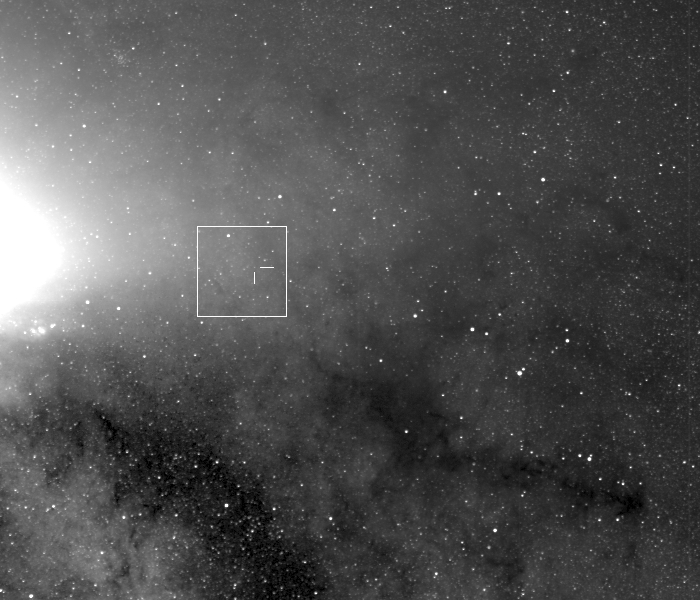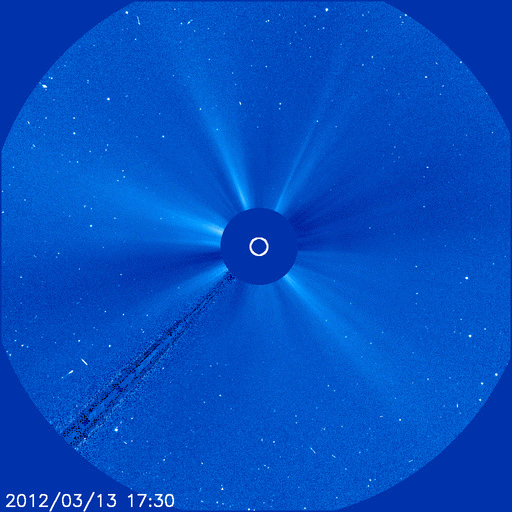Could this be the next great comet? To be sure, these words have been said lots of times before. In a clockwork sky, how comets will perform is always the great wildcard. Comets from Kohoutek to ISON have failed to live up to expectations, while others like W3 Lovejoy took us all by surprise. But a discovery this past weekend has message boards abuzz, as an incoming sungrazer could put on a show right around Halloween.
Continue reading “Could a New Sungrazer Comet Put on a Show at the End of October?”A New Sungrazing Comet May Brighten in the Evening Sky, Here’s How to See It
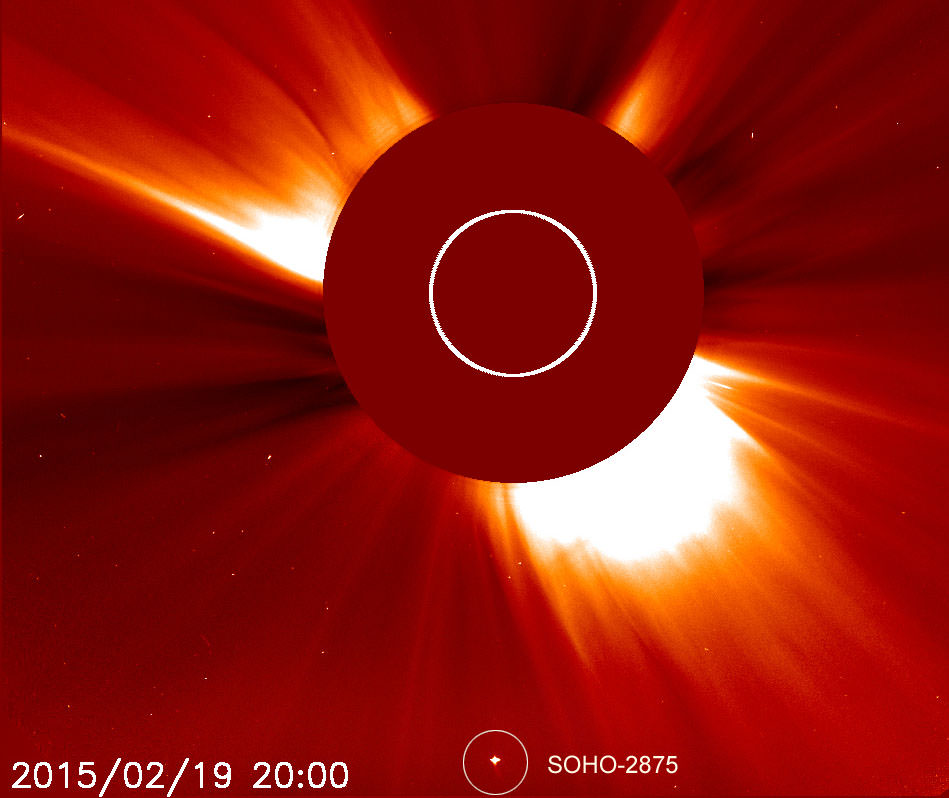
A newly-discovered comet may soon become bright enough to see from a sky near you. Originally dubbed SOHO-2875, it was spotted in photos taken by the Solar and Heliospheric Observatory (SOHO) earlier this week. Astronomer Karl Battams, who maintains the Sungrazer Project website, originally thought this little comet would dissipate after its close brush with the Sun. To his surprise, it outperformed expectations and may survive long enough to see in the evening sky.
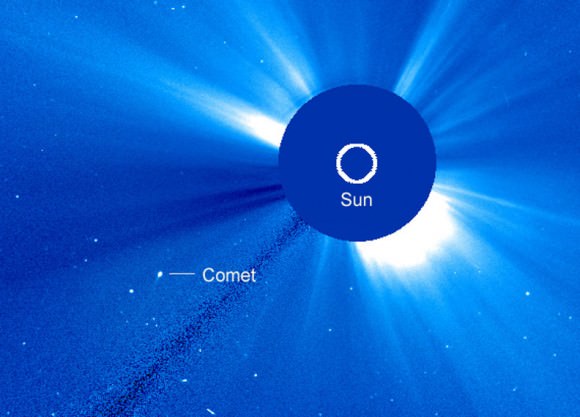
Most sungrazing comets discovered by SOHO are members of the Kreutz family, a group of icy fragments left over from the breakup of a single much larger comet centuries ago. We know they’re all family by their similar orbits. The newcomer, SOHO’s 2,875th comet discovery, is a “non-group” comet or one that’s unrelated to the Kreutz family or any other comet club for that matter. According to Battams these mavericks appear several times a year. As of today (Feb. 24) its official name is C/2015 D1 (SOHO).
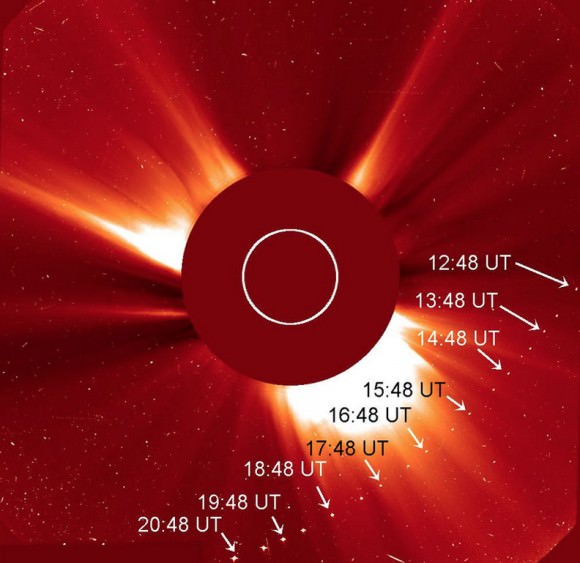
What’s unusual about #2,875 is how bright it is. At least for now, it appears to have survived the Sun’s heat and gravitational tides and is turning around to the east headed for the evening sky. Before it left SOHO’s field of view on Feb. 21, the comet was still around magnitude +4-4.5.
No one can say for sure whether it has what it takes to hang on, so don’t get your hopes up just yet. Battams and others carefully calculated the comet’s changing position in the SOHO images and sent the data off to the Minor Planet Center, which today published an orbit.
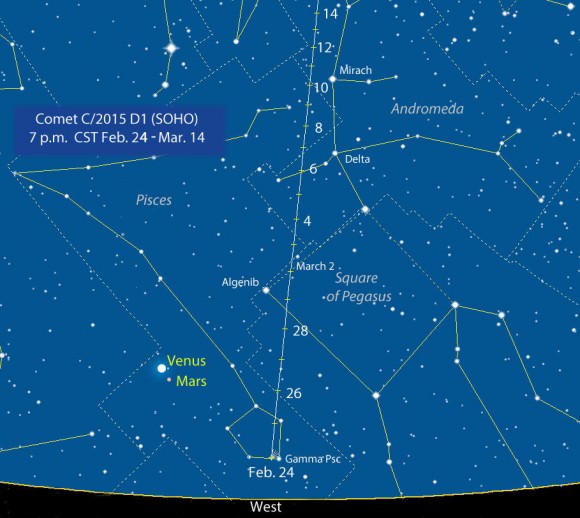
Based on this preliminary orbit, I’ve plotted SOHO-2875’s path for the next couple weeks as it tracks up through Pisces and Pegasus during the early evening hours. Given that it’s probably no brighter than magnitude +6 at the moment and very low in the west at dusk, it may still be swamped in twilight’s glow.
Barring an unexpected outburst, there’s no question that the comet will fade in the coming days as its distance from both the Earth and Sun increase. Right now it’s 79 million miles from us and 28 million miles from the Sun. That puts it about 8 million miles closer to the Sun than the planet Mercury.
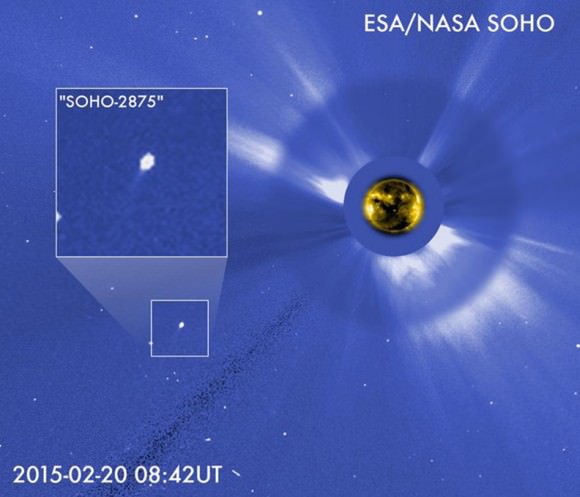
I drew up the chart for about 75 minutes after sunset in late twilight. Keep in mind that since the comet’s positions were determined via spacecraft imagery, which isn’t as precise as photographing it from ground observatories, its orbit is preliminary. That means it may not be on the precise path shown on the map. Be sure you search up-down and right-left of the plotted locations.
It’s also very possible the comet is in the process of disintegration after perihelion passage, so it may not be a dense, compact object but rather a diffuse cloud of glowing dust. Will it go the way of Comet ISON and fade away to nothing? Who knows? I sure don’t but can’t wait to find out what it’s up to the next clear night.
BTW, if you’ve got a software program that downloads orbital elements for comets to create your own charts, you’ll find the numbers you need in today’s Minor Planet Circular. Be sure to use the “post-perihelion” elements that predict the comet’s location from here on out.
NASA’s STEREO Spots a New Nova
While on duty observing the Sun from its position in solar orbit, NASA’s STEREO-B spacecraft captured the sudden appearance of a distant bright object. This flare-up turned out to be a nova — designated Sagittarii 2012 — the violent expulsion of material and radiation from a re-igniting white dwarf star.
Unlike a supernova, which is the cataclysmic collapse and explosion of a massive star whose core has finally fused its last, a nova is the result of material falling onto the surface of a white dwarf that’s part of a binary pair. The material, typically hydrogen and helium gas, is drawn off the white dwarf’s partner which has expanded into a red giant.
Eventually the white dwarf cannot contain all of the material that it has sucked in from its neighbor… material which has been heated to tremendous temperatures on its surface as it got compressed further and further by the white dwarf’s incredibly strong gravity. Fusion occurs on the dwarf’s outermost layers, blasting its surface out into space in an explosion of light and energy.
This is a nova — so called because, when witnessed in the night sky, one could suddenly appear as a “new star” in the heavens — sometimes even outshining all other visible stars!
An individual nova will soon fade, but a white dwarf can produce many such flares over time. It all depends on how rapidly it’s accreting material (and how much there is available.)
Over the course of 4 days, Sagittarii 2012 reached a magnitude of about 8.5… still too dim to be seen with the unaided eye, but STEREO-B was able to detect it with its SECCHI (Sun Earth Connection Coronal and Heliospheric Investigation) instrument, which is sensitive to extreme ultraviolet wavelengths.
The video above was made from images acquired from April 20 – 24, 2012.
It’s not known yet how far away Sagittarii 2012 is but rest assured it poses no threat to Earth. The energy expelled by a nova is nowhere near that of a supernova, and although you wouldn’t want to have a front-row seat to such an event we’re well away from the danger zone.
What this does show is that STEREO-B is not only a super Sun-watching sentinel, but also very good at observing much more distant stars as well!
Thanks to @SungrazerComets for the heads-up on this novel nova!
[/caption]
So Long, SWAN…
Remember that newly-discovered comet we mentioned a couple of days ago? Well, it’s gone. Poof. Into the Sun and never to return, it was a sungrazer’s final voyage.
The video above features images from the SOHO spacecraft and description from Bad Astronomer Phil Plait, with music by Kevin MacLeod.
Alas, poor SWAN… at least we knew him.
Read more about the history of Comet SWAN on the Sungrazing Comets site. Video credit: NASA/SOHO (and thanks to Phil Plait for the assembly.)
A New Comet’s SWAN Dive Into the Sun
[/caption]
A new comet has been discovered by the SOHO team, and it — like Lovejoy before it, almost three months to the day — is headed directly toward the Sun. Discovered by SOHO’s SWAN instrument, the comet has been dubbed Comet SWAN… making this a real swan dive (or, perhaps more appropriately, its swan song.)
The animation above has a lot of random noise in it from recent solar outbursts… can you spot the comet? If not, read on…

There’s Comet SWAN, just above the darker silhouette of the bar that holds the shielding disk over the center of the imager (which blocks the glare from the Sun itself.)
The comet is likely another member of the Kreutz family of comets, an extended family of pieces that broke off a larger comet several hundred years ago (which itself may have been a survivor of a breakup in 371 B.C.!) Comet Lovejoy was also a Kretuz sungrazer but it was considerably larger and brighter, which may have helped it survive its Dec. 15 solar close encounter to re-emerge on the opposite side, surprising astronomers everywhere!
Read how some scientists think Comet Lovejoy held itself together.
SWAN may not be so lucky… but then again, we’ve been surprised before!
The comet will make perihelion — its closest approach to the Sun — on March 14. Stay tuned for more details!
Images via SpaceWeather.com.


